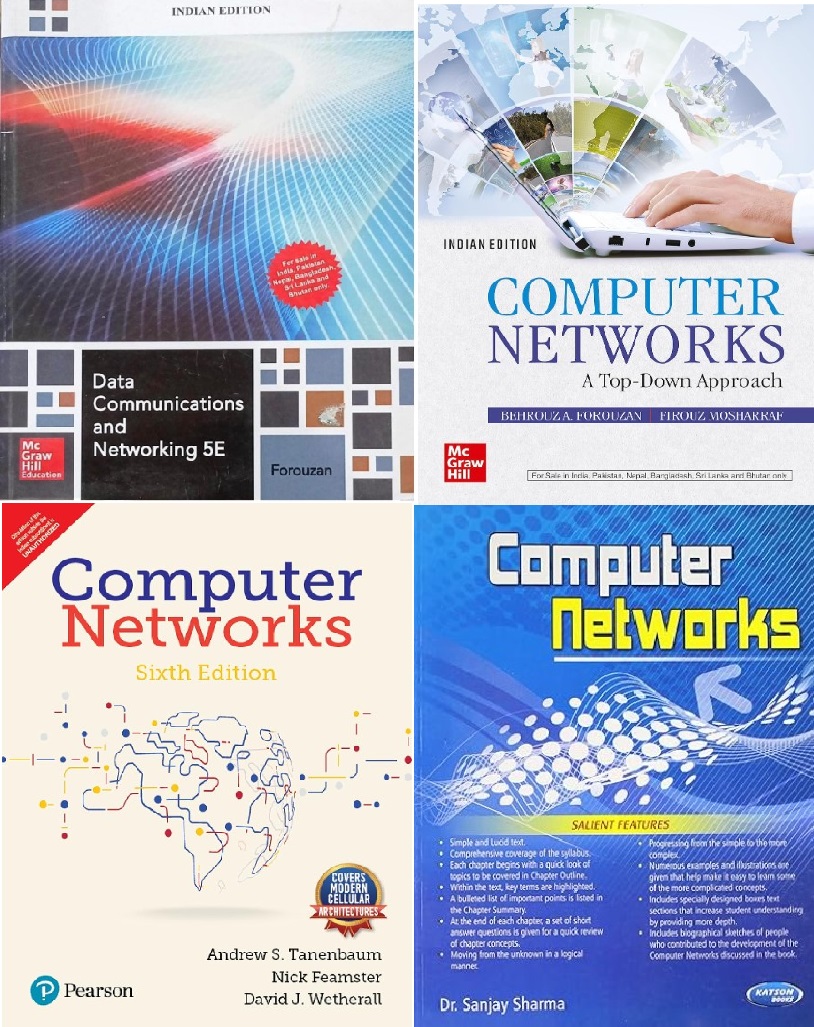UNIT 2: Physical Layer
Physical Layer: Transmission media, Signal transmission and encoding, Network performance and transmission impairments, Switching techniques and multiplexing, Overview of PSTN, ISDN, and ATM
Q101 – If the bandwidth of the link is greater than the bandwidth needed, the bandwidth is
Preserved
Utilize for other communications
Wasted
None of the Above
Ans – (2)
Explanation –
When the available bandwidth exceeds the required bandwidth, the excess capacity is not used effectively, leading to a waste of resources.
But this unused bandwidth cannot be utilized for other communications unless dynamically allocated or shared, it means it is utilized for other communications.
Q102 – The multiplexing technique that is used when the data rate of an input line is a multiple of others is called
multilevel multiplexing
multiple-slot allocation
pulse stuffing
Asynchronous TDM
Ans – (1)
Explanation –
The multiplexing technique that is used when the data rate of an input line is a multiple of others is called multilevel multiplexing.
This technique is used when different channels or input lines have different data rates, with some input lines having data rates that are multiples of others. It allows efficient use of available bandwidth by accommodating various data rates.
Q103 – A special band is assigned to Amplitude Modulation (AM) radio from
500 to 1700 kHz
540 to 1700 kHz
600 to 1500 kHz
200 to 2000kHz
Ans – (2)
Explanation –
The AM radio frequency band typically spans from 540 kHz to 1700 kHz in most regions, including North America. This range is allocated specifically for AM radio broadcasts.
The AM broadcast band in India spans from 530 kHz to 1605 kHz. This range is designated for AM radio transmission and covers the medium wave (MW) band used for AM radio broadcasts.
Q104 – In multiplexing process, the term ‘link’ refers to the
media
physical path.
power lines
information
Ans – (2)
Explanation –
In the context of multiplexing, a ‘link’ refers to the physical communication path or medium over which multiple signals are transmitted simultaneously. This path can be a wire, fiber optic cable, or any other communication medium that carries the multiplexed signals from one point to another.
Q105 – In synchronous TDM, the data rate of the link is n times faster and the unit duration is
n times shorter
n+1 times shorter
n-1 times shorter
remains same
Ans – (1)
Explanation –
In synchronous TDM, the data rate of the link is n times the rate of each individual input signal. Consequently, the duration of each time slot (unit duration) for the multiplexed data must be n times shorter to accommodate the faster data rate and ensure that each time slot is still of appropriate length for transmitting the data from each channel. This shorter unit duration allows the multiplexed data to be transmitted efficiently at the higher link data rate.
Q106 – In multiplexing, channels are separated by unused strips of bandwidth guard bands – to prevent
Synchronization
Overlapping
random motion of electrons
Both b and c
Ans – (2)
Explanation –
These are unused frequency bands placed between adjacent channels to prevent interference and overlapping of signals. Guard bands ensure that the signals from different channels do not interfere with each other, maintaining signal integrity and preventing overlap.
Q107 – ________ is a virtual-circuit wide-area network that was designed in response to demands for a new type of WAN in the late 1980s and early 1990s.
X.25
Frame Relay
ATM
none of the above
Ans – (2)
Explanation –
Frame Relay is a virtual-circuit wide-area network that was designed in response to demands for a new type of WAN in the late 1980s and early 1990s.
This technology was developed to provide a faster and more efficient way to handle data communications over wide-area networks (WANs) compared to older technologies like X.25. It offers virtual circuits that efficiently manage data frames and was widely adopted in the 1990s.
Q108 – Frame Relay provides ________.
PVCs
SVCs
either (1) or (2)
neither (1) nor (2)
Ans – (3)
Explanation –
PVCs (Permanent Virtual Circuits) – Frame Relay supports Permanent Virtual Circuits, which are pre-established paths used for data transmission between endpoints. PVCs are configured to provide consistent, dedicated communication channels.
SVCs (Switched Virtual Circuits) – Although Frame Relay does offer SVCs, they are less common compared to PVCs. SVCs are dynamically established as needed and provide a connection only for the duration of the session.
Q109 – In Frame Relay, when a _____ is selected, the corresponding table entry is recorded for all switches by the administrator
PVC
SVC
either (1) or (2)
neither (1) nor (2)
Ans – (1)
Explanation –
In Frame Relay, when a PVC (Permanent Virtual Circuit) is selected, the corresponding table entry is recorded for all switches by the administrator.
When a PVC is set up in Frame Relay, it involves the creation of a permanent path that remains constant and is recorded in the routing tables of all switches involved. The configuration for PVCs is maintained consistently across the network switches, allowing for reliable and continuous communication.
Q110 – In Frame Relay, when ______ is selected, it requires establishing and terminating phases
a PVC
an SVC
either (1) or (2)
neither (1) nor (2)
Ans – (2)
Explanation –
In Frame Relay, when an SVC (Switched Virtual Circuit) is selected, it requires establishing and terminating phases.
SVCs require dynamic setup and teardown phases. They are created and terminated on-demand, meaning that each connection involves establishing a path when needed and terminating it once the communication is complete.
Q111 – Frame Relay has _______.
only the physical layer
only the data link
the physical and data link layers
the physical, data link, and network layers
Ans – (3)
Explanation –
Physical Layer – Frame Relay operates over physical transmission media, which can be various types of physical networks.
Data Link Layer – Frame Relay provides functionality at the data link layer, where it handles frame relay-specific protocols and manages data framing, error checking, and flow control.
Network Layer – Frame Relay does not operate at the network layer. It provides virtual circuits at the data link layer but relies on network layer protocols (like IP) for routing and addressing.
Q112 – At the data link layer, Frame Relay uses a protocol that supports _____control.
flow
error
either (1) or (2)
neither (1) nor (2)
Ans – (4)
Explanation –
Flow Control – Frame Relay does not provide flow control mechanisms at the data link layer. Flow control is managed by higher-layer protocols if needed.
Error Control – Frame Relay also does not provide error control at the data link layer. Instead, it relies on higher-layer protocols for error detection and correction.
Q113 – In Frame Relay, an address can be ________ bytes.
only 2
2 to 3
2 to 4
4 to 8
Ans – (3)
Explanation –
Frame Relay addresses, known as Data Link Connection Identifiers (DLCIs), typically range from 2 to 4 bytes in length. The exact length depends on the specific Frame Relay implementation and the network configuration. The DLCI is used to uniquely identify virtual circuits within the Frame Relay network.
Q114 – In ATM, a virtual connection is defined by _________.
VPI
VCI
DLCI
a combination of (a) and (b)
Ans – (4)
Explanation –
In ATM (Asynchronous Transfer Mode), a virtual connection is defined by a combination of (1) and (2).
VPI (Virtual Path Identifier) – This identifies the virtual path in which the ATM cells travel.
VCI (Virtual Channel Identifier) – This identifies the specific virtual channel within the virtual path.
Together, the VPI and VCI uniquely define a virtual connection in ATM, allowing for the routing and management of cells through the ATM network.
Q115 – _________ is the interface between two ATM switches.
UNI
NNI
NNN
None of the above
Ans – (2)
Explanation –
NNI (Network-to-Network Interface) – This is the interface used between ATM switches or routers within an ATM network. It is used to connect different ATM networks or switches and allows for the exchange of ATM cells between them.
Q116 – ________ technology can be adapted for use in a LAN (ATM LAN).
X.25
Frame Relay
ATM
none of the above
Ans – (3)
Explanation –
ATM (Asynchronous Transfer Mode) – ATM can be used in Local Area Networks (LANs) to provide high-speed and efficient data transfer. It is well-suited for LAN environments where high bandwidth and low latency are required.
Q117 – In a _______ ATM LAN, the backbone that connects traditional LANs uses ATM technology.
pure
legacy
mixed architecture
none of the above
Ans – (2)
Explanation –
Legacy ATM LAN – In this architecture, ATM technology is used as the backbone to connect traditional LANs (such as Ethernet or token ring networks). The ATM network provides high-speed and efficient data transfer across the different LANs connected to it.
Q118 – The type of packet format supported by X.25 are as follows
Control packet
Data packet
Both 1 & 2
None of these
Ans – (3)
Explanation –
The type of packet format supported by X.25 are as follows Both 1 & 2
Control Packet – X.25 uses control packets to manage and control the network connections. These packets handle tasks such as establishing, maintaining, and terminating connections.
Data Packet – X.25 also uses data packets to carry user data across the network.
Q119 – Advantages of cell relay are
High-speed transmission
Multiplexing transmission
Both a & b
None of these
Ans – (3)
Explanation –
High-speed Transmission – Cell relay technologies, such as ATM (Asynchronous Transfer Mode), are designed to provide high-speed data transmission. They use fixed-size cells to ensure efficient and fast data transfer.
Multiplexing Transmission – Cell relay allows for multiplexing multiple data streams over a single network link. This means it can combine various types of data into a single stream, optimizing the use of network resources.
Q120 – Type of ATM service used for regroup timing requirements?
variable bit rate
constant bit rate
available bit rate
unspecified bit rate
Ans – (2)
Explanation –
Constant Bit Rate (CBR) – This service provides a fixed and predictable data rate, which is ideal for applications requiring strict timing and quality of service guarantees, such as real-time audio and video. It ensures that the bandwidth is reserved and maintained throughout the connection.



